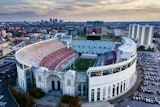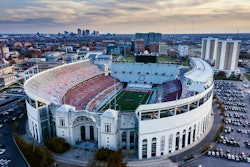Today's grassroots Olympic development programs are introducing nontraditional sports to a new generation of often-disadvantaged youths.
To the elementary and middle school students of San Antonio's Southside Independent School District, the proposal sounded more like work than sport. "When we told the kids that we were going to teach them fencing, they went home and told their parents we were going to teach them how to put up fences," says Alma Martinez-Striker, assistant executive director of youth programs for the nonprofit San Antonio Sports Foundation. "That's how much they knew."
The Southside students' knowledge of swordplay has expanded significantly in the eight years since San Antonio was named by the United States Olympic Committee as the host city of one of four pilot Community Olympic Development Programs (CODPs), this generation's Olympic festivals. (Salt Lake City, Atlanta and Minneapolis/St. Paul were the other three pilot CODP cities.) Created with the goal of identifying and fostering athletic talent among youths at the grassroots level, CODPs have been established in eight cities and one county and are taking it upon themselves to introduce youths, especially those from underprivileged and underrepresented groups, to nontraditional Olympic sports.
In San Antonio, for example, youths are being exposed to gymnastics, fencing, volleyball, diving and badminton for the first time. The San Antonio Sports Foundation relies on partnerships with area parks and recreation agencies, private sports clubs, colleges and public school districts to deliver its programs. Through its community Olympic development and Dreams for Youth programs -- the latter being the foundation's 12-year-old youth sports initiative that spurred USOC officials to select San Antonio as a CODP host city -- the San Antonio Sports Foundation has provided 90,000 area youths at least a glimmer of Olympic hope.
"Some of the kids in that program have really heart-warming stories," says Carolyn Wheat, the San Antonio Sports Foundation's public relations manager. "One girl who's a fencer in our program is 16 years old, 6-foot-2 and African-American -- that fact alone makes her a minority in her sport. Her mom is a single parent, and without the CODP, she could not travel to all the competitions she needs to get points. There's a boy, in badminton, who started at the elementary school level. He was talented, so the coaches asked him to participate in the after-school leagues, which led to the CODP, and now he's traveling all over the country. I mean, he was on the free lunch program. These are the kinds of kids we hope to reach."
At the USOC, outreach has replaced ostentation. The Olympic festivals of the 1980s and '90s -- often weeklong celebrations during which concerts, fairs and parades sandwiched national team qualifying events in a handful of sports -- turned nobodies into household names. Not only did these festivals act as venues for up-and-coming athletes to showcase their talent, they also served as publicity vehicles for host cities such as St. Louis and Seattle. Some of the multimillion-dollar events were marketing successes, but not all. "A lot of the national governing bodies and many of the athletes thought the festivals were useful, but they were becoming larger and larger events," says Alicia McConnell, director of the USOC's Athlete Development Programs. "We're always trying to have events that create opportunities for athletes, that improve their competitive experience. But festivals were just getting too expensive."
Matthew Ryan, senior director of club services for the Boys & Girls Clubs of Metro Atlanta and that city's CODP manager, believes that Olympic festivals distracted NGB officials from their primary task: grassroots athlete development. "A lot of NGBs have focused so much on the elite athlete and elite events -- and that has been able to sustain them for a period of time. But there has been a lack of focus on grassroots development, and they're starting to feel the effects of it," he says. "You need to have a pipeline. You need to have a feeder system that goes all the way from the bottom level to the top."
By the mid-'90s, USOC officials were looking for a more effective means by which to discover potential Olympians, and in 1997, the Community Olympic Development Program was born. As conceived at the time, the CODP would operate as a two-tier program: First, nonprofit community-based sports and recreation organizations would manage programs that would expose large numbers of youths to Olympic sports such as judo and team handball. Then, CODP coaches would glean from the masses a smaller group of children who either excelled at or showed a heightened interest in a particular sport, or both. Ultimately, McConnell says these youths would be "handed over to the national governing bodies," which would assume the role of providing the youths funding to help cover costs of travel to competitions, advanced coaching, equipment and other training necessities.
One of the key criteria used by the USOC when evaluating each candidate CODP site is its capacity and desire to collaborate with the national governing body in the particular sport on which that city wants to focus. The converse must also be true. "We don't just want to start a program in a community and have it not be sustainable," says McConnell.
For example, USA Track & Field officials only endorsed the mountain resort town of Flagstaff, Ariz. -- named a CODP host site in 2001 -- because they could see the potential benefit to their organization of creating a long-distance-runner development program. "With Flagstaff being a high-altitude site, the focus there is endurance running," says McConnell. "Track & Field was behind it. They said, 'We think this place can help with our athletic development pipeline.' "
Even more critical, though, is that each CODP lives up to its name -- especially the "community" part. "In Springfield, Mo., we started with weightlifting and tennis," says McConnell, who noted the strength of a youth tennis program operated through Springfield-Greene County Parks when she visited the area in June 2001 (Springfield was named a CODP site two years later). "Tennis isn't necessarily a nontraditional sport; however, it's very much a part of the community. We didn't feel that we should be the ones to say, 'You can't do tennis,' because they' reintroducing thousands of kids to tennis who otherwise wouldn't have played."
A community must take an ownership mentality in its CODP for it to be successful, says McConnell. "City council members care about these programs. They feel they make a difference. Usually, we'll have a program board of directors or a steering committee that involves a lot of high-powered people in the community, like the school district superintendent, a city commissioner or a city councilperson. You have the decision-makers of the community sitting there on the steering committee making decisions for the youths."
It's fitting, then, that among the individuals responsible for such decisions in Springfield are a public recreation professional and a pediatrician. Springfield CODP manager Linda Dollar gives a great deal of credit for her program's success to Jodie Adams, assistant director of parks with Springfield-Greene County Parks, and Dr. Bernard Griesemer of the HealthTracks Sports Training Center. HealthTracks is operated by the St. John's Clinic, a multi-specialty medical practice.
"Those two basically initiated the CODP," says Dollar, herself a former head volleyball coach and assistant athletic director at Southwest Missouri State University. "Dr. Griesemer had been involved in drug testing at several Olympics, so he has that burning Olympic spirit. But being a pediatrician, he also wanted to do some things to address obesity in children. And Jodie Adams has always had an interest here in Springfield in promoting youth development, and with all of her ties with the park system it seemed like a natural fit."
Those connections have come in handy for the Springfield CODP. Its youth tennis program is housed at the Cooper Tennis Complex, an indoor/outdoor facility owned by Springfield-Greene County Parks, and HealthTracks runs the weightlifting program. There, local youths have the benefit of training under the supervision of two former Olympic weightlifters. Though both are full-time HealthTracks employees, the personal trainers provide their services to Springfield CODP participants on a part-time basis, helping alleviate program costs.
Managing such costs can be difficult for any CODP director, particularly in light of the fact that since 2001 the USOC has required all CODPs to be self-sustaining. (Each of the four pilot programs received a four-year seed grant of $1 million, or $250,000 annually.) Though, generally speaking, only a handful of youths take full advantage of a CODP, the costs to help even a small group advance through the Olympic development ranks can be tremendous. (The Springfield program, for example, provides free tennis lessons and after-school weightlifting classes for local schoolchildren, but according to Dollar, only 20 youths train full-time.)
To earn points to improve their national or international rankings in their chosen sport, Olympians-in-training must travel to a number of regional, national and international competitions. Fencers and badminton players with the San Antonio CODP regularly travel overseas, "and we pay all of their expenses," says Martinez-Striker.
But only those youths who show a high level of dedication and love for their sport while maintaining passing grades in school receive such sponsorship. "The intent is to help athletes who really need it," says Wheat. "Just because you're a good athlete doesn't mean that you qualify for funding."
The San Antonio Sports Foundation also purchases all of its own equipment for badminton, fencing and volleyball. The cost to equip just one fencer, according to Martinez-Striker, tops $1,000. Add those costs to salaries for 25 part-time coaches and an office staff of a half-dozen people, and it's easy to see how quickly Martinez-Striker's $500,000 annual youth sports budget evaporates. A variety of supplementary sources help keep the San Antonio CODP afloat -- grant funds, corporate sponsorships and a loyal pool of volunteers among them. "Volunteers are the lifeblood of our organization," Wheat says. "And we certainly rely on our coaches to do much more than they get paid for. Because they're also mentors, they put in tons of hours above and beyond the actual time that they're coaching."
The San Antonio CODP coaches firmly believe that all of their time and effort will eventually pay off. Wheat says that the program's badminton coach, a former Olympic festival athlete and two-time USA Badminton Developmental Coach of the Year, is "determined to get a couple of his athletes in the Olympics. He wants them to go to Beijing.
Atlanta's Ryan wants the same for his track and field, team handball and judo athletes. Given their recent success on the national stage, Ryan is more than hopeful that at least a few of his program's participants will earn a spot on the 2008 U.S. Olympic team. "In the sport of team handball, we've channeled four girls to the junior national team," he says. "With track and field, we've had about 1,500 kids come through the program, and more than 50 have gone on to qualify and compete at the junior national championship level. We've had 12 national champions. And these are all just kids who had been exposed to their sports for the first time."
None of this would have been possible had the Centennial Legacy Foundation of the 1996 Olympic Games -- which founded the Atlanta CODP -- not transferred its endowment fund of nearly $500,000 to the Boys & Girls Clubs of Metro Atlanta last year to continue the program's administration.
That endowment, which pays about 80 percent of the Atlanta CODP's costs, has enabled Ryan and his staff to embrace the USOC's intentions for CODPs to be self-sustaining and, in turn, create revenue-generating events. These include "all-comer" meets that are open to all local Boys & Girls Clubs members, as well as large-scale annual invitationals that attract adult and youth competitors from all over Georgia. "Seventy percent of the 26,000 youths we serve through the Boys & Girls Clubs of Metro Atlanta are under the poverty line," says Ryan. "Our kids are doing things that, financially, they otherwise would never dream of doing."
And that's exactly the point. "It's a community effort," Ryan adds. "The city of Atlanta has really embraced what we've done and what we continue to do. And until these kids become either Olympians or professional athletes, we want to continue opening doors."




































